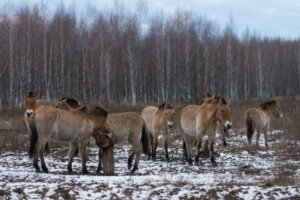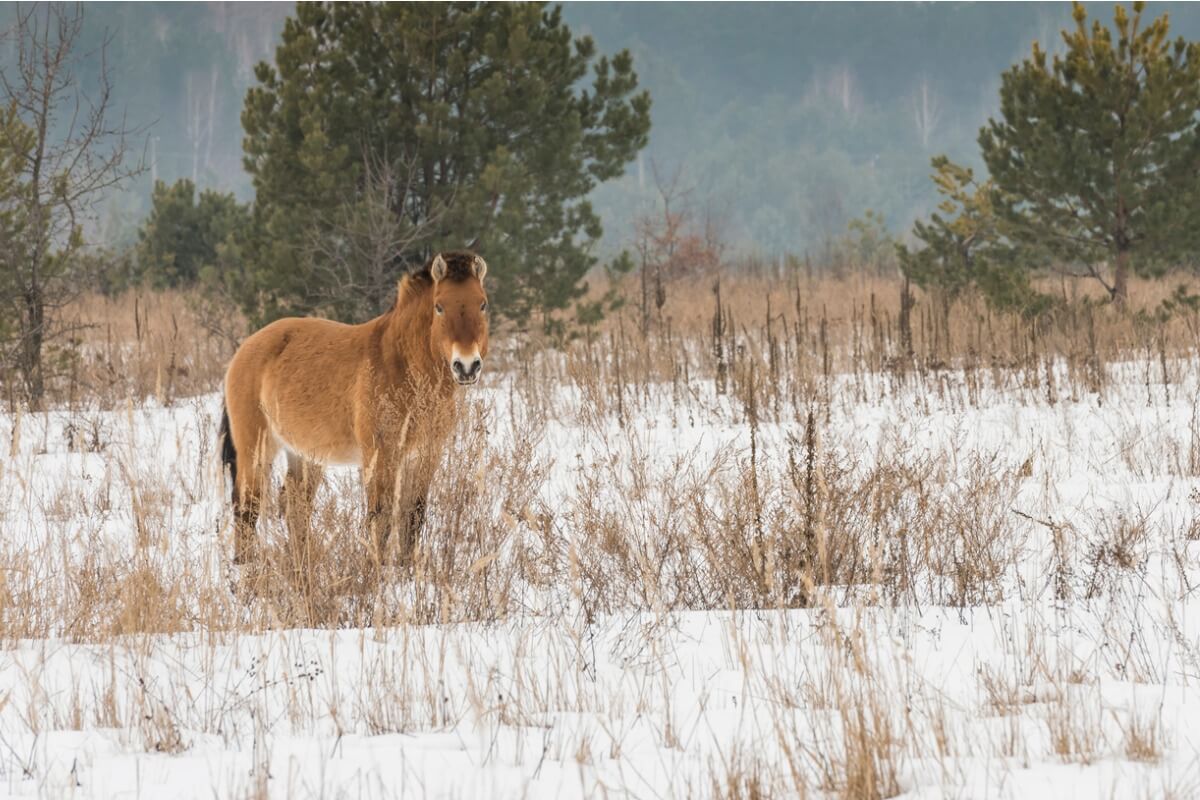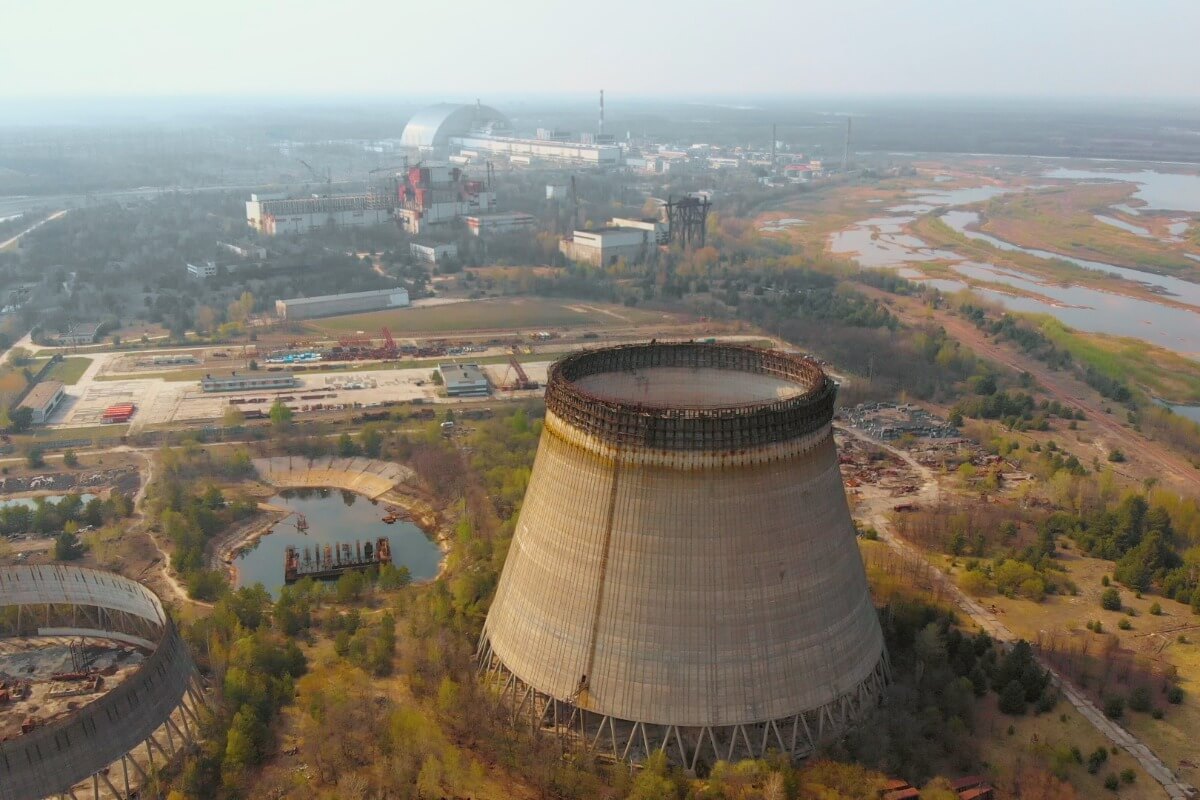The Chernobyl Horses: How Do They Survive?


Written and verified by the biologist Francisco Morata Carramolino
The Chernobyl disaster caused the evacuation of the city and its surroundings. After the explosion, it was estimated that the entire area would remain as an uninhabitable wasteland for thousands of years. However, after the disappearance of humans, wildlife has flourished again and the horses of Chernobyl are living proof of this.
Despite sky-high levels of radiation, Chernobyl has become a haven for its lush biodiversity. Animal species that are disappearing from other places due to human pressure have colonized this place and have large populations.
This is the case with Przewalski’s horses, which were introduced into Chernobyl 12 years after the explosion. These equidae have been on the brink of extinction, so their growing populations in the exclusion zone constitute a unique opportunity for their conservation. If you want to learn more about them, keep reading.
Characteristics of Chernobyl horses
Until a few years ago, Przewalski’s horses were believed to be the only remaining wild horse species in the world. However, recent studies published in the journal Science have discovered they are feral descendants of horses domesticated by the Botai, one of the first cultures that domesticated these animals.
Currently, these equines are classified under the subspecies Equus ferus przewalskii. Although they’re not really pure wild horses, they’re the closest thing. As such, they retain many of the characteristics that ancient wild ancestors displayed.
Przewalski’s horses are smaller, shorter, and more muscular than typical domestic specimens. Its general appearance is robust and somewhat plump and the color is tan or orange in most of the body, becoming darker on the head.
The muzzle and belly of these horses are white. The legs, the tail and the mane, which runs along the neck and head, are black. During winter, these mammals develop thick fur, while in summer it is shorter.

Przewalski’s horse ecology
These horses usually live in herds, which typically consist of an adult male, a number of females, and their young. When the young reach 2 or 3 years of age, they leave these herds. Young females often join other established herds.
Males, on the other hand, form herds with other young males or males too old to defend groups of females. When they reach around 5 years of age, the males try to form their own herds, snatching them from other males or attracting dispersing females.
Its natural range has been almost completely destroyed by humans. Therefore, they’re currently only found in parts of China, Mongolia, and of course around Chernobyl in Ukraine and Belarus.
Regarding their habitats, these horses are usually found in grasslands, steppes or semi-desert areas. The presence of herbaceous vegetation or scrub, on which they feed, is important. Chernobyl horses often use abandoned human structures as shelter, to protect themselves from the cold or parasites.
How have the Chernobyl horses survived?
Radiation levels at Chernobyl have decreased since the explosion. Even so, they’re still incredibly dangerous to all multicellular living beings, including humans.
Today, the specific effects of radiation on animals in this area aren’t entirely known. Even so, it has been observed that these equids have a higher mutation rate, have more deformities and defects, shorter life expectancy and a series of other problems that threaten their health.
In addition, there appears to be less abundance of some animals in areas with a higher amount of radiation. Invertebrate species seem to be especially suffering from these effects.
On the other hand, it’s possible that animals are developing physiological or behavioral adaptations to resist radiation, although this is still being investigated.
Despite all this, it’s clear that Chernobyl animals are thriving like few other places on the planet. This seems especially true for large mammal species, which are less and less abundant in the rest of the world.
This strange situation seems to indicate that the pressure exerted by humans on the environment is even more serious than the explosion of a nuclear reactor. Despite such damaging radiation, wild animals are able to thrive as long as humans and their influence disappear.

Chernobyl serves today as an unusual refuge for wildlife. Given this unexpected opportunity, it’s important to protect the area and not recover human activity. This will allow the conservation of their species and will ensure the people’s health.
The Chernobyl disaster caused the evacuation of the city and its surroundings. After the explosion, it was estimated that the entire area would remain as an uninhabitable wasteland for thousands of years. However, after the disappearance of humans, wildlife has flourished again and the horses of Chernobyl are living proof of this.
Despite sky-high levels of radiation, Chernobyl has become a haven for its lush biodiversity. Animal species that are disappearing from other places due to human pressure have colonized this place and have large populations.
This is the case with Przewalski’s horses, which were introduced into Chernobyl 12 years after the explosion. These equidae have been on the brink of extinction, so their growing populations in the exclusion zone constitute a unique opportunity for their conservation. If you want to learn more about them, keep reading.
Characteristics of Chernobyl horses
Until a few years ago, Przewalski’s horses were believed to be the only remaining wild horse species in the world. However, recent studies published in the journal Science have discovered they are feral descendants of horses domesticated by the Botai, one of the first cultures that domesticated these animals.
Currently, these equines are classified under the subspecies Equus ferus przewalskii. Although they’re not really pure wild horses, they’re the closest thing. As such, they retain many of the characteristics that ancient wild ancestors displayed.
Przewalski’s horses are smaller, shorter, and more muscular than typical domestic specimens. Its general appearance is robust and somewhat plump and the color is tan or orange in most of the body, becoming darker on the head.
The muzzle and belly of these horses are white. The legs, the tail and the mane, which runs along the neck and head, are black. During winter, these mammals develop thick fur, while in summer it is shorter.

Przewalski’s horse ecology
These horses usually live in herds, which typically consist of an adult male, a number of females, and their young. When the young reach 2 or 3 years of age, they leave these herds. Young females often join other established herds.
Males, on the other hand, form herds with other young males or males too old to defend groups of females. When they reach around 5 years of age, the males try to form their own herds, snatching them from other males or attracting dispersing females.
Its natural range has been almost completely destroyed by humans. Therefore, they’re currently only found in parts of China, Mongolia, and of course around Chernobyl in Ukraine and Belarus.
Regarding their habitats, these horses are usually found in grasslands, steppes or semi-desert areas. The presence of herbaceous vegetation or scrub, on which they feed, is important. Chernobyl horses often use abandoned human structures as shelter, to protect themselves from the cold or parasites.
How have the Chernobyl horses survived?
Radiation levels at Chernobyl have decreased since the explosion. Even so, they’re still incredibly dangerous to all multicellular living beings, including humans.
Today, the specific effects of radiation on animals in this area aren’t entirely known. Even so, it has been observed that these equids have a higher mutation rate, have more deformities and defects, shorter life expectancy and a series of other problems that threaten their health.
In addition, there appears to be less abundance of some animals in areas with a higher amount of radiation. Invertebrate species seem to be especially suffering from these effects.
On the other hand, it’s possible that animals are developing physiological or behavioral adaptations to resist radiation, although this is still being investigated.
Despite all this, it’s clear that Chernobyl animals are thriving like few other places on the planet. This seems especially true for large mammal species, which are less and less abundant in the rest of the world.
This strange situation seems to indicate that the pressure exerted by humans on the environment is even more serious than the explosion of a nuclear reactor. Despite such damaging radiation, wild animals are able to thrive as long as humans and their influence disappear.

Chernobyl serves today as an unusual refuge for wildlife. Given this unexpected opportunity, it’s important to protect the area and not recover human activity. This will allow the conservation of their species and will ensure the people’s health.
All cited sources were thoroughly reviewed by our team to ensure their quality, reliability, currency, and validity. The bibliography of this article was considered reliable and of academic or scientific accuracy.
- Gaunitz, C., Fages, A., Hanghøj, K., Albrechtsen, A., Khan, N., Schubert, M., … & Orlando, L. 2018. Ancient genomes revisit the ancestry of domestic and Przewalski’s horses. Science, 360: 111-114.
- Yablokov, A. V., Nesterenko, V. B., & Nesterenkob, A. V. 2010. Chapter III. Consequences of the Chernobyl catastrophe for the environment. Chernobyl, 221.
- Møller, A. P., & Mousseau, T. A. 2013. Assessing effects of radiation on abundance of mammals and predator–prey interactions in Chernobyl using tracks in the snow. Ecological Indicators, 26: 112-116.
- Schlichting, P. E., Dombrovski, V., & Beasley, J. C. 2020. Use of abandoned structures by Przewalski’s wild horses and other wildlife in the Chernobyl Exclusion Zone. Mammal Research, 65: 161-165.
- https://theconversation.com/chernobyl-has-become-a-refuge-for-wildlife-33-years-after-the-nuclear-accident-116303
- https://www.nationalgeographic.com/animals/mammals/facts/przewalskis-horse
- https://www.iucnredlist.org/species/41763/97204950
- https://theconversation.com/the-mystery-of-chernobyls-wild-horses-137270
This text is provided for informational purposes only and does not replace consultation with a professional. If in doubt, consult your specialist.








